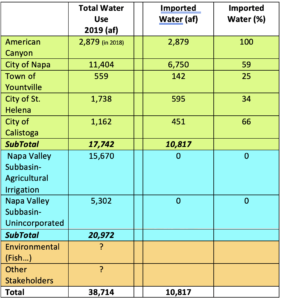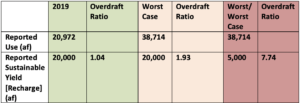By Daniel Mufson, Ph.D.
The Atlas/Tubbs Fire changed life for thousands. Covid-19 changed life for millions. Now imagine what life will become when the unquestionable effects of climate change diminish our water supply through drought, heat, loss of watershed forests, and salt-water intrusion.
The state Sustainable Groundwater Management Act requires that each local agency establish sustainability goal for the basin that culminates in the elimination of undesirable results within 20 years of the applicable statutory deadline. The agency’s purpose is intended to strengthen the connection between land use planning and water management: no water, then no development.
The Napa Valley Sub-basin SGMA Sustainability Goal is:
To protect and enhance groundwater quantity and quality for all the people who live and work in Napa County, regardless of the source of their water supply. The County and everyone living and working in the county will integrate stewardship principles and measures in groundwater development, use, and management to protect economic, environmental, and social benefits and maintain groundwater sustainability indefinitely without causing undesirable results, including unacceptable economic, environmental, or social consequences.
The first step in water budget is to compare how much water we use to how much water we have. The County has issued its latest GW Sustainability Report for the Water Year 2019. Let’s see some of their data from its 294 pages:
The Good News
We’re told that the GW sub-basin is doing great – that there is lots of water therein with year to year fluctuations and a sustainable yield range of 17,000 to 20,000 acre-feet per year identified in the Basin Analysis Report (LSCE, 2016c).
The Sobering News
The county imports water (State Water Project), on behalf of the municipalities, delivered via the North Bay Aqueduct. This comprised 50% of municipal water use in water year 2019 not counting American Canyon. Local reservoirs within the Subbasin watershed supplied 42% of municipal water use in water year 2019. Groundwater pumped from the Subbasin accounted for 2% of the municipal water use in recent years. Recycled water comprised 6% of municipal water use in water year 2019.
But Wait: What about American Canyon’s Water?
As American Canyon is not part of the NV sub-basin, the Napa County GW Sustainability Report does not include their water use. But if we are to clearly assess the water needs of Napa County and its municipalities then we must add in American Canyon. Data from Figure 4-9 in the LAFCO report indicates that the total water use in American Canyon was 2,879 acre-feet (af) in 2018 with an estimated usage of 3,405 af in 2020.
If we add the American Canyon water use to the NV subbasin data we find that at least 38,714 af of water was used in 2019 as seen below:
Table 1. Water Use in Napa County

The Water Budget Arithmetic
With 80% of Napa County residents living in the cities, we need a master plan to supply them with water when the state water project is no longer able to deliver the current allocations and their reservoirs are compromised by drought or polluting runoff.
The Urgency is Here
While we were drafting this report, St. Helena announced a water emergency increasing the reality of our concern (June 26, 2020).
St. Helena Water Emergency: City Enacts Phase I Measures Bell Canyon Reservoir is currently 60-percent full and is projected to drop as low as 33-percent full by November. In 2019, 47% of St. Helena’s water came from this diminishing Bell Canyon Reservoir, 34% was imported from the state and 18% from groundwater. St Helena is the only city using groundwater at this time.
The total water use in Napa County in 2019 as shown in Table 1 is 38,714 af. The sustainable yield for the sub-basin is said to be 18,000 –20,000 af annually. Assuming 20,000 af is sustainable, in a worst-case scenario (no imported water available) the municipalities will need to share the GW with existing users. That means that an additional 18,705 af will have to be extracted, essentially a doubling of the Overdraft Ratio—an unsustainable situation similar to the situation in the Central Valley over past years.
Table 2. Groundwater Overdraft Situations

In this worst-case scenario, the cities and Ag users will have to decrease their water consumption by half in order to maintain a sustainable aquifer. Attention will have to be paid to the steps we can follow to accomplish the required reductions.
In the, worst/worst-case (no imported water coupled with very dry years locally which diminish both surface water and groundwater) the recharge of the aquifer is decreased which reduces the sustainable yield (we estimated 5000 af for this example) causing the overdraft ratio to markedly increase.
This analysis is the heart of the issue before us. We can debate the likelihood and timing of these scenarios (although for St. Helena reality has arrived): How much water do we have, how much is used, and who gets it? That’s what we need to plan for. And we must plan for sufficient water flow in the Napa River for those who live there!
We wish the newly minted members of the Napa County Ground Water Sustainability Plan Agency Committee and the Drought Contingency Task Force great wisdom, and fortitude, as they embark on that master plan to sustainably provide water for all of us…the Commons.
